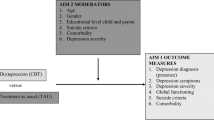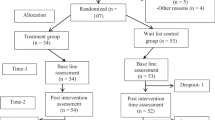Abstract
Despite their prevalence, depression and suicidal ideation (SI) are relatively unaddressed problems in the college student population. There are limited individual treatment studies targeting this population. Nine students (M = 19.33 years of age; SD ± .87) with depressive symptoms and/or SI were enrolled in 6-weeks of individual cognitive behavioral therapy (CBT) with a individually tailored manual-based treatment delivery. Measures were given before and after treatment. Primary results, presented as a case series, suggested decreases in depression across students and an overall downward trend in SI. As a secondary analysis, paired samples t tests showed significant decreases in both depression and SI. In summary, short-term, individually tailored manual-based CBT may be beneficial for reducing depressive symptoms and SI among college students. More research is needed to determine the best clinical interventions and targeted treatments for this vulnerable population.

Similar content being viewed by others
References
American College Health Association. (2000). National college health assessment: Reference group executive summary, fall 2000. Baltimore: Author.
American College Health Association. (2007). American college health association national college health assessment Spring 2006 reference group data report. Journal of American College of Health, 55(4), 195–206.
American College Health Association. (2008). National college health assessment: Reference group data report, spring 2008. Baltimore: Author.
American College Health Association. (2008). National college health assessment: Reference group executive summary fall 2008. Baltimore: Author.
American College Health Association. (2011). ACHS-National health assessment II: Reference group executive summary spring 2011. Hanover: Author.
Barrios, L. C., Everett, S. A., Simon, T. R., & Brener, N. D. (2000). Suicide ideation among US college students: associations with other injury risk behaviors. Journal of American College Health, 48(5), 229–233.
Beck, A. T., Ward, C. H., Mendelson, M., Mock, J., & Erbaugh, J. (1961). An inventory for measuring depression. Archives of General Psychiatry, 4, 53–63.
Brown, G. K., Have, T. T., Henriques, G. R., Xie, S., Hollander, J., & Beck, A. T. (2005). Cognitive therapy for the prevention of suicide attempts. Journal of the American Medical Association, 294(5), 563–570.
Church, D., De Asis, M. A., & Brooks, A. J. (2012). Brief group intervention using emotional freedom techniques for depression in college students: A randomized controlled trial. Depression Research and Treatment, 2012, 1–7.
Comtois, K. A., & Linehan, M. M. (2006). Psychosocial treatments of suicidal behaviors: A practice-friendly review. Journal of Clinical Psychology, 62(2), 161–170.
Cotton, C. R., Peters, D. K., & Range, L. M. (1995). Psychometric properties of the suicidal behaviors questionnaire. Death Studies, 19, 391–397.
Davies, S., Naik, P. C., & Lee, A. S. (2001). Depression, suicide, and the national service framework. BMJ, 322(7301), 1500–1501.
Davis, L., Barlow, D. H., & Smith, L. (2010). Comorbidity and the treatment of principal anxiety disorders in a naturalistic sample. Behavior Therapy, 41(3), 296–305.
Eisenberg, D., Hunt, J., Speer, N., & Zivin, K. (2011). Mental health service utilization among college students in the United States. The Journal of Nervous and Mental Disease, 199(5), 301.
Farabaugh, A., Alpert, J., Wisniewski, S. R., Otto, M. W., Fava, M., Baer, L., & Thase, M. E. (2012a). Cognitive therapy for anxious depression in STAR*D: What have we learned? Journal of Affective Disorders, 142(1), 213–218.
Farabaugh, A., Bitran, S., Nyer, M., Holt, D. J., Pedrelli, P., Shyu, I., & Fava, M. (2012b). Depression and suicidal ideation in college students. Psychopathology, 45(4), 228–234.
Goldsmith, S. K., Pellar, T. C., Kleinman, A. M., & Bunney, W. E. (2002). Reducing suicide: A national imperative. Washington, DC: The National Academies Press.
Hamdan-Mansour, A. M., Al-Gamal, E., Puskar, K., Yacoub, M., & Marini, A. (2011). Mental health nursing in Jordan: An investigation into experience, work stress and organizational support. International Journal of Mental Health Nursing, 20(2), 86–94.
Hunt, J., & Eisenberg, D. (2010). Mental health problems and help-seeking behavior among college students. Journal of Adolescent Health, 46(1), 3–10.
Jobes, D. A. (2000). Collaborating to prevent suicide: A clinical research perspective. Suicide and Life Threatening Behavior, 30(1), 8–17.
Joffe, P. (2008). An empirically supported program to prevent suicide in a college student population. Suicide and Life Threatening Behavior, 38(1), 87–103.
Kisch, J., Leino, V., & Silverman, M. (2005). Aspects of suicidal behavior, depression, and treatment in college students: results from the spring 2000 national college health assessment survey. Suicide and Life Threatening Behavior, 35(1), 3–12.
Lerner, M. S., & Clum, G. A. (1990). Treatment of suicide ideators: A problem-solving approach. Behavior Therapy, 21(4), 403–411.
Levitt, J. T., Malta, L. S., Martin, A., Davis, L., & Cloitre, M. (2007). The flexible application of a manualized treatment for PTSD symptoms and functional impairment related to the 9/11 World Trade Center attack. Behaviour Research and Therapy, 45(7), 1419–1433.
Linehan, M. M. (2008). Suicide intervention research: A field in desperate need of development. Suicide and Life-Threatening Behavior, 38(5), 483–485.
Mann, J. J., Apter, A., Bertolote, J., Beautrais, A., Currier, D., Haas, A., & Hendin, H. (2005). Suicide prevention strategies: A systematic review. Journal of the American Medical Association, 294(16), 2064–2074.
Nock, M. K., Deming, C. A., Chiu, W. T., Hwang, I., Angermeyer, M., Borges, G., et al. (2012). Mental disorders, comorbidity, and suicidal behavior. In M. K. Nock, G. Borges, & Y. Ono (Eds.), Suicide: Global Perspectives from the WHO World Mental Health Surveys (pp. 148–163). New York: Cambridge University Press.
Nock, M. K., Hwang, I., Sampson, N. A., & Kessler, R. C. (2009). Mental disorders, comorbidity and suicidal behavior: Results from the National Comorbidity Survey Replication. Molecular Psychiatry, 15(8), 868–876.
Osman, A., Bagge, C. L., Guitierrez, P. M., Konick, L. C., Kooper, B. A., & Barrios, F. X. (2001). The Suicidal Behaviors Questionnaire-Revised (SBQ-R): Validation with clinical and nonclinical samples. Assessment, 5, 443–454.
Peden, A. R., Rayens, M. K., Hall, L. A., & Beebe, L. H. (2001). Preventing depression in high-risk college women: A report of an 18-month follow-up. Journal of American College Health, 49(6), 299–306.
Pistorello, J., Fruzzetti, A. E., MacLane, C., Gallop, R., & Iverson, K. M. (2012). Dialectical behavior therapy (DBT) applied to college students: A randomized clinical trial. Journal of Consulting and Clinical Psychology, 80(6), 982–994.
Regehr, C., Glancy, D., & Pitts, A. (2013). Interventions to reduce stress in university students: A review and meta-analysis. Journal of Affective Disorders, 148(1), 1–11.
Reid, W. H. (2010). Preventing suicide. Journal of Psychiatric Practice, 16(2), 120–124.
Reynolds, W. M., & Gould, J. W. (1981). A psychometric investigation of the standard and short form Beck Depression Inventory. Journal of Consulting and Clinical Psychology, 49(2), 306.
Seligman, M. E., Schulman, P., & Tryon, A. M. (2007). Group prevention of depression and anxiety symptoms. Behaviour Research and Therapy, 45(6), 1111–1126.
Shaw, B. F. (1984). Specification of the training and evaluation of cognitive therapists for outcome studies. In J. B. W. Williams & R. L. Spitzer (Eds.), Psychotherapy Research: Where we are and where we should go?: Proceedings of the 73rd Annual Meeting of the American Psychopathological Association, New York City, March 3–5, 1983 (pp. 173–189). New York: Guilford Press.
Stewart, C. D., Health, M., Quinn, A., Plever, S., Clin, M., & Emmerson, B. (2009). Comparing cognitive behavior therapy, problem solving therapy, and treatment as usual in a high risk population. Suicide and Life Threatening Behavior, 39(5), 538–547.
Tarrier, N., Taylor, K., & Gooding, P. (2008). Cognitive behavioral interventions to reduce suicide behavior: A systematic review and meta-analysis. Behavior Modification, 32(1), 77–108.
Thase, M., Friedman, E., Biggs, M., Wisniewski, S., Trivedi, M., Luther, J., & Rush, A. (2007). Cognitive therapy versus medication in augmentation and switch strategies as second-step treatments: A STAR* D report. American Journal of Psychiatry, 164(5), 739–752.
Trockel, M., Manber, R., Chang, V., Thurston, A., & Tailor, C. B. (2011). An e-mail delivered CBT for sleep-health program for college students: effects on sleep quality and depression symptoms. Journal of clinical sleep medicine: JCSM: official publication of the American Academy of Sleep Medicine, 7(3), 276.
Turner, D. P., Thompson, M. E., Huber, L. R. B., & Arif, A. A. (2012). Depressive symptoms and academic performance of North Carolina college students. Mental Health, 73(3), 169–175.
US Department of Health and Human Services, (2001). National strategy for suicide prevention: goals and objectives for action. Rockville, MD: US Public Health Service (document No SMA3517). Retrieved from www.mentalhealth.org/suicideprevention.
US Department of Health & Human Services. (2010). Mental health and mental disorders Healthy People 2010. Washington, DC: Government Printing Office.
Watkins, D. C., Hunt, J. B., & Eisenberg, D. (2012). Increased demand for mental health services on college campuses: Perspectives from administrators. Qualitative Social Work, 11(3), 319–337.
Westfall, J. M., Mold, J., & Fagnan, L. (2007). Practice-based research—“Blue Highways” on the NIH roadmap. JAMA, 297(4), 403–406.
Wingo, J., Kalkut, E., Tuminello, E., Asconape, J., & Han, S. D. (2013). Executive functions, depressive symptoms, and college adjustment in women. Applied Neuropsychology Adult, 20(2), 136–144.
Wisniewski, S., Fava, M., Trivedi, M., Thase, M., Warden, D., Niederehe, G., & Rush, A. (2007). Acceptability of second-step treatments to depressed outpatients: a STAR* D report. American Journal of Psychiatry, 164(5), 753–760.
Author information
Authors and Affiliations
Corresponding author
Rights and permissions
About this article
Cite this article
Nyer, M.B., Cassiello-Robbins, C., Nock, M.K. et al. A Case Series of Individual Six-Week Cognitive Behavioral Therapy With Individually Tailored Manual-Based Treatment Delivery for Depressed College Students With or Without Suicidal Ideation. J Rat-Emo Cognitive-Behav Ther 33, 134–147 (2015). https://doi.org/10.1007/s10942-015-0206-y
Published:
Issue Date:
DOI: https://doi.org/10.1007/s10942-015-0206-y




